
An aircraft carrier is a warship that serves as a seagoing airbase, equipped with a full-length flight deck and facilities for carrying, arming, deploying, and recovering aircraft. Typically, it is the capital ship of a fleet, as it allows a naval force to project air power worldwide without depending on local bases for staging aircraft operations. Carriers have evolved since their inception in the early twentieth century from wooden vessels used to deploy balloons to nuclear-powered warships that carry numerous fighters, strike aircraft, helicopters, and other types of aircraft. While heavier aircraft such as fixed-wing gunships and bombers have been launched from aircraft carriers, these aircraft have not landed on a carrier. By its diplomatic and tactical power, its mobility, its autonomy and the variety of its means, the aircraft carrier is often the centerpiece of modern combat fleets. Tactically or even strategically, it replaced the battleship in the role of flagship of a fleet. One of its great advantages is that, by sailing in international waters, it does not interfere with any territorial sovereignty and thus obviates the need for overflight authorizations from third-party countries, reduces the times and transit distances of aircraft and therefore significantly increases the time of availability on the combat zone.

The Fleet Air Arm (FAA) is the naval aviation component of the United Kingdom's Royal Navy (RN). The FAA is one of five RN fighting arms. As of 2023 it is a predominantly "rotary" force, with helicopters undertaking roles once performed by biplanes such as the Fairey Swordfish. It operates the F-35 Lightning II for maritime strike and the AW159 Wildcat and AW101 Merlin for commando and anti-submarine warfare.

The flight deck of an aircraft carrier is the surface from which its aircraft take off and land, essentially a miniature airfield at sea. On smaller naval ships which do not have aviation as a primary mission, the landing area for helicopters and other VTOL aircraft is also referred to as the flight deck. The official U.S. Navy term for these vessels is "air-capable ships".

The Tailhook Association is a U.S.-based non-profit organization supporting the interests of sea-based aviation, with emphasis on aircraft carriers. The word tailhook refers to the hook underneath the tail of the aircraft that catches the arresting wire suspended across the flight deck in order to stop the landing plane quickly.

Naval aviation is the application of military air power by navies, whether from warships that embark aircraft, or land bases.

The Vought F7U Cutlass was a United States Navy carrier-based jet fighter and fighter-bomber designed and produced by the aircraft manufacturer Chance Vought. It was the first tailless production fighter in the United States as well as United States Navy's first jet equipped with swept wings and the first to be designed with afterburners.
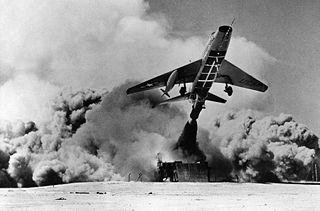
The zero-length launch system or zero-length take-off system was a method whereby jet fighters and attack aircraft could be near-vertically launched using rocket motors to rapidly gain speed and altitude. Such rocket boosters were limited to a short-burn duration, being typically solid-fuel and suitable for only a single use, being intended to drop away once expended.
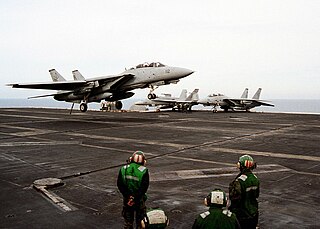
An arresting gear, or arrestor gear, is a mechanical system used to rapidly decelerate an aircraft as it lands. Arresting gear on aircraft carriers is an essential component of naval aviation, and it is most commonly used on CATOBAR and STOBAR aircraft carriers. Similar systems are also found at land-based airfields for expeditionary or emergency use. Typical systems consist of several steel wire ropes laid across the aircraft landing area, designed to be caught by an aircraft's tailhook. During a normal arrestment, the tailhook engages the wire and the aircraft's kinetic energy is transferred to hydraulic damping systems attached below the carrier deck. There are other related systems that use nets to catch aircraft wings or landing gear. These barricade and barrier systems are only used for emergency arrestments for aircraft without operable tailhooks.

The Electromagnetic Aircraft Launch System (EMALS) is a type of electromagnetic catapult system developed by General Atomics for the United States Navy. The system launches carrier-based aircraft by means of a catapult employing a linear induction motor rather than the conventional steam piston. EMALS was first installed on the lead ship of the Gerald R. Ford-class aircraft carrier, USS Gerald R. Ford.

The Northrop Grumman X-47B is a demonstration unmanned combat aerial vehicle (UCAV) designed for aircraft carrier-based operations. Developed by the American defense technology company Northrop Grumman, the X-47 project began as part of DARPA's J-UCAS program, and subsequently became part of the United States Navy's Unmanned Combat Air System Demonstration (UCAS-D) program. The X-47B is a tailless jet-powered blended-wing-body aircraft capable of semi-autonomous operation and aerial refueling.
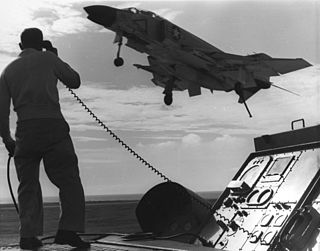
A landing signal officer or landing safety officer (LSO), also informally known as paddles or batsman, is a naval aviator specially trained to facilitate the "safe and expeditious recovery" of naval aircraft aboard aircraft carriers. LSOs aboard smaller air capable ships that launch and recover helicopters are informally known as deck. Originally LSOs were responsible for bringing aircraft aboard ship using hand-operated signals. Since the introduction of optical landing systems in the 1950s, LSOs assist pilots by giving information via radio handsets.

In naval aviation, a bolter occurs when an aircraft attempting an arrested landing on the flight deck of an aircraft carrier touches down, but fails to catch an arrestor cable and come to a stop. Bolter aircraft accelerate at full throttle and become airborne in order to go-around and re-attempt the landing.

The North American FJ-1 Fury was an early turbojet-powered carrier-capable fighter aircraft used by the United States Navy (USN). Developed by North American Aviation (NAA) starting in 1945, it became the first jet aircraft in USN service to serve at sea under operational conditions. This first version of the FJ was a straight-winged jet, briefly operational during the transition to more successful designs. An evolution of the FJ-1 would become the land-based XP-86 prototype of the United States Air Force's enormously influential F-86 Sabre, which in turn formed the basis for the Navy's carrier-based, swept-winged North American FJ-2/-3 Fury.

Modern United States Navy aircraft carrier air operations include the operation of fixed-wing and rotary aircraft on and around an aircraft carrier for performance of combat or noncombat missions. The flight operations are highly evolved, based on experiences dating back to 1922 with USS Langley.

Fighter Squadron Composite 204 (VFC-204), also known as the "River Rattlers", is a United States Navy Reserve adversary squadron, slated to fly the F-5N/F Tiger II after having previously flown the F/A-18C/D Hornet. The squadron is based out of Naval Air Station Joint Reserve Base New Orleans, Louisiana, and is part of the U.S. Navy Reserve's Tactical Support Wing. Their radio callsign is "River" and their tail code is "AF".
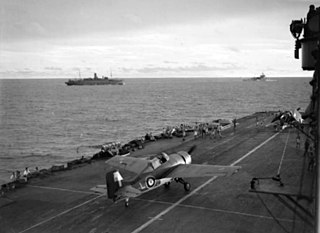
Aircraft carriers are warships that evolved from balloon-carrying wooden vessels into nuclear-powered vessels carrying many dozens of fixed- and rotary-wing aircraft. Since their introduction they have allowed naval forces to project air power great distances without having to depend on local bases for staging aircraft operations.

A carrier-based aircraft is a naval aircraft designed for operations from aircraft carriers. Carrier-based aircraft must be able to launch in a short distance and be sturdy enough to withstand the abrupt forces of launching from and recovering on a pitching deck. In addition, their wings are generally able to fold up, easing operations in tight quarters.

James Henry Flatley III, is a retired rear admiral in the United States Navy. A naval aviator, fighter pilot, and test pilot, he is the son of Vice Admiral James H. Flatley.
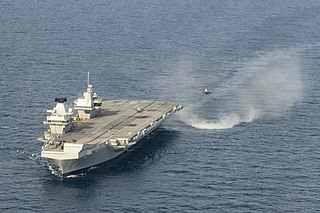
Shipborne rolling vertical landing (SRVL) is a method used to land a V/STOL aircraft that uses both the vertical thrust from the jet engine and lift from the wings.

Ernest Eugene (Gene) Tissot Jr. was a United States Navy Rear Admiral and naval aviator who was highly decorated for his actions during the Korean War and the Vietnam War. He was born in Upland, California, and entered the Navy as a Naval Aviation Cadet in June 1945 and learned to fly in the Stearman N2S biplane at the Naval Air Station Livermore in August 1946. He was designated a Naval Aviator in June 1948 and commissioned as an Ensign that December. He was advanced in rank to Captain in January 1969 and his selection for the rank of Rear Admiral was approved by the President in March 1973.

























